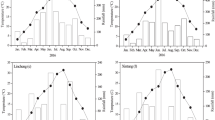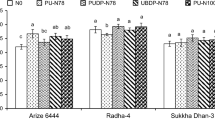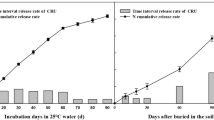Abstract
Optimizing agronomic management plays a vital role in improving nitrogen (N) use efficiency (NUE) of rice. One-time deep application of fertilizer, especially root-zone fertilization (RZF), has already been regarded as an effective simplified fertilization method to improve rice yield and NUE. However, few studies have explored the effect of RZF on the yield and NUE in the ratoon rice system. Consequently, a 2-year field experiment was conducted, including five treatments: no N fertilizer (CK), farmers’ familiar practice (FFP), RZF of controlled-release urea (CRU) applied once into small holes with a depth of 5 cm and a distance of 5 cm away from the rice plants as basal fertilizer (RZF1); RZF of CRU applied once into small holes with a depth of 10 cm and a distance of 5 cm away from the rice plants as basal fertilizer (RZF2); and RZF of CRU applied once into small holes with depths of both 5 and 10 cm and a distance of 5 cm away from the rice plants as basal fertilizer (RZF3). The rice was planted under continuous flooding (CF) or alternate wetting and drying (AWD). The results showed that RZF2 and RZF3 increased annual yield of ratoon rice by 4.8–6.0% and 7.1–12.3% under CF, and by 5.7–7.4% and 10.9–11.0% under AWD compared with FFP, respectively. Compared with FFP, RZF2 and RZF3 significantly increased N use efficiency. The combination of RZF3 and AWD resulted in the highest water and N use efficiency.








Similar content being viewed by others
References
Afroz H, Islam MR, Islam MR (2014) Floodwater nitrogen, rice yield and N use efficiency as influenced by deep placement of nitrogenous fertilizers. J Environ Sci Nat Resour 7:207–213. https://doi.org/10.3329/jesnr.v7i1.22173
Bandaogo A, Bidjokazo F, Youl S, Safo E, Abaidoo R, Andrews O (2015) Effect of fertilizer deep placement with urea supergranule on nitrogen use efficiency of irrigated rice in Sourou Valley (Burkina Faso). Nutr Cycl Agroecosyst 102(1):79–89. https://doi.org/10.1007/s10705-014-9653-6
Belder P, Bouman BAM, Cabangon RJ, Lu G, Quilang EJP, Li Y, Spiertz JHJ, Tuong TP (2004) Effect of water-saving irrigation on rice yield and water use in typical lowland conditions in Asia. Agr Water Manag. https://doi.org/10.1016/j.agwat.2003.09.002
Cao SQ, Lu W, Zhai HQ, Sheng SL, Gong HB, Yang TN, Zhang RX (2001) Research on the method to estimating flag leaf photosynthesis function duration at rice seedling stage by relative steady phase of chlorophyll content. Chin J Rice Sci 15(4):309–313. https://doi.org/10.1088/0022-3719/18/14/103. (in Chinese)
Cao YS, Tian YH, Yin B, Zhu ZL (2013) Assessment of ammonia volatilization from paddy fields under crop management practices aimed to increase grain yield and N efficiency. Field Crops Res 147:23–31. https://doi.org/10.1016/j.fcr.2013.03.015
Cao XC, Wu LL, Zhu CQ, Zhu LF, Kong YL, Lu RH, Kong HM, Hu ZP, Dai F, Zhang JH, Jin QY (2021) Effects of different irrigation and nitrogen application regimes on the yield, nitrogen utilization of rice and nitrogen transformation in paddy soil. Sci Agric Sin 54(7):1482–1498. https://doi.org/10.3864/j.issn.0578-1752.2021.07.013. (in Chinese)
Cao YX, Zhu JQ, Hou J (2020) Yield gap of ratoon rice and their influence factors in China. Sci Agric Sin 53:707–719. https://doi.org/10.3864/j.issn.0578-1752.2020.04.004. (in Chinese)
Carrijo DR, Lundy ME, Linquist BA (2017) Rice yields and water use under alternate wetting and drying irrigation: a meta-analysis. Field Crops Res 203:173–180. https://doi.org/10.1016/j.fcr.2016.12.002
Fan XR, Jia LJ, Li YL, Smith SJ, Miller AJ, Shen QR (2007) Comparing nitrate storage and remobilization in two rice cultivars that differ in their nitrogen use efficiency. J Exp Bot 58:1729–1740. https://doi.org/10.1093/jxb/erm033
He AB, Wang WQ, Jiang GL, Sun HJ, Jiang M, Man JG, Gui KH, Huang JL, Peng SB, Nie LX (2019) Source-sink regulation and its effects on the regeneration ability of ratoon rice. Field Crops Res 236:155–164. https://doi.org/10.1016/j.fcr.2019.04.001
Hu R, Ding ZJ, Li TY, Zhang DY, Tian YB, Cao YX, Hou J (2022a) Optimizing nitrogen application for Chinese ratoon rice based on yield and reactive nitrogen loss. Agriculture 12:1064. https://doi.org/10.3390/agriculture12071064
Hu R, Xiao DK, Ding ZJ, Yang S, Li JT, Huang F, Tian YB, Hou J (2022b) Effects of nitrogen application in root zone on growth and distribution of rice roots at seedling stage. Jangsu Agric Sci 1–8 (in Chinese).
Huang SY, Tian C, Xie GX, Ou Z, Liu Q, Peng JW (2019) Mechanism and suitable application dosage of controlled-release urea effectively reducing ammonia volatilization in double-cropping paddy fields. Plant Nutr Fert Sci 25(12):2102–2112. https://doi.org/10.11674/zwyf.19297. (in Chinese)
Huda A, Gaihre YK, Islam MR, Singh U, Islam MR, Sanabria J, Satter MA, Afroz H, Halder A, Jahiruddin M (2016) Floodwater ammonium, nitrogen use efficiency and rice yields with fertilizer deep placement and alternate wetting and drying under triple rice cropping systems. Nutr Cycl Agroecosyst 104:53–66. https://doi.org/10.1007/s10705-015-9758-6
Kapoor V, Singh U, Patil SK, Magre H, Shrivastava LK, Mishra VN, Das RO, Samadhiya VK, Sanabria J, Diamond R (2008) Rice growth, grain yield, and floodwater nutrient dynamics as affected by nutrient placement method and rate. Agron J 100(3):526–536. https://doi.org/10.2134/agronj2007.0007
Ke J, He RC, Hou PF, Ding C, Ding YF, Wang SH, Liu ZH, Tang S, Ding CQ, Chen L, Li GH (2018) Combined controlled-released nitrogen fertilizers and deep placement effects of N leaching, rice yield and N recovery in machine-transplanted rice. Agr Ecosyst Environ 265:402–412. https://doi.org/10.1016/j.agee.2018.06.023
Khush G, Gupta P (2013) Strategies for increasing the yield potential of cereals: case of rice as an example. Plant Breed 132:433–436. https://doi.org/10.1111/pbr.1991
Liu XW, Chen XQ, Wang HY, Lu DJ, Zhou JM, Chen ZM, Zhu DJ (2017) Effects and principle of root-zone one-time N fertilization on enhancing rice (Oryza sativa L.) N use efficiency. Soils 49(5):868–875. https://doi.org/10.13758/j.cnki.tr.2017.05.002. ((in Chinese))
Liu TQ, Fan DJ, Zhang XX, Chen J, Li CF, Cao CG (2015) Deep placement of nitrogen fertilizers reduces ammonia volatilization and increases nitrogen utilization efficiency in no-tillage paddy fields in central China. Field Crop Res 184:80–90. https://doi.org/10.1016/j.fcr.2015.09.011
Liu RL, Wang F, Wang KJ, Zhang AP, Li YH, Hong Y, Yang ZL (2018) Effects of side strip application of controlled release nitrogen fertilizer on rice yield and nitrogen loss in Northeast China. J Soil Water Conserv 32(02):252–256. https://doi.org/10.13870/j.cnki.stbcxb.2018.02.037. (in Chinese)
Liu XW, Wang HY, Zhou JM, Hu FQ, Zhu DJ, Chen ZM, Liu YZ (2016) Effect of N fertilization pattern on rice yield, N use efficiency and fertilizer-N fate in the Yangtze River Basin, China. PLoS One 11(11):e0166002. https://doi.org/10.1371/journal.pone.0166002
Liu ZH, Wu XB, Tan DS, Li Y, Jiang LH (2018) Application and environmental effects of one-off fertilization technique in major cereal crops in China. Sci Agric Sin 51(20):3827–3839. https://doi.org/10.3864/j.issn.0578-1752.2018.20.002. (in Chinese)
Mahajan G, Ghauhan BS, Timsina J, Singh PP, Singh K (2012) Crop performance and water-and nitrogen-use efficiencies in dry-seeded rice in response to irrigation and fertilizer amounts in northwest India. Field Crops Res 134:59–70. https://doi.org/10.1016/j.fcr.2012.04.011
Mo ZW, Pan SG, Wang ZM, Luo XW, Tian H, Duan MY, Tang XR (2013) Effects of deeply mechanized fertilizer application on rice quality and nutrient absorption and utilization of direct seeding rice. J Huazhong Agric Univ 32(05):34–39. https://doi.org/10.13300/j.cnki.hnlkxb.2013.05.010. (in Chinese)
Peng SB, Tang QY, Zhou YB (2008) Current status and challenges of rice production in China. Plant Prod Sci 12:3–8. https://doi.org/10.1626/pps.12.3
Shen JB, Li CJ, Mi GH, Li L, Yuan LX, Jiang RF, Zhang FS (2013) Maximizing root/rhizosphere efficiency to improve crop productivity and nutrient use efficiency in intensive agriculture of China. J Exp Bot 64:1181–1192. https://doi.org/10.1093/jxb/ers342
Sun HY (2015) Effects of fertilization methods on root growth, nutrition absorption of rice and soil nutrition distribution. HuaZhong Agricultural University, Wuhan ((in Chinese))
Tan X, Shao D, Liu H, Yang F, Xiao C, Yang H (2013) Effects of alternate wetting and drying irrigation on percolation and nitrogen leaching in paddy fields. Paddy Water Environ 11:1–15. https://doi.org/10.1007/s10333-012-0328-0
Wang S, Mo JH, Wang Y, You QX, Ren T, Cong RH, Li XK (2018) Dry matter accumulation and N, P, K absorption and utilization in rice-ratoon rice system. Chin J Rice Sci 32(1):67–77. https://doi.org/10.16819/j.1001-7216.2018.7027. (in Chinese)
Wu M, Liu M, Liu J, Li WT, Jiang CY, Li ZP (2017) Optimize nitrogen fertilization location in root-growing zone to increase grain yield and nitrogen use efficiency of transplanted rice in subtropical China. J Integr Agr 16(9):2073–2081. https://doi.org/10.1016/S2095-3119(16)61544-7
Yang YC, Zhang M, Zheng L, Cheng DD, Liu M, Geng YQ, Chen JQ (2013) Controlled-release urea for rice production and its environment implications. J Plant Nutr 36(5):781–794. https://doi.org/10.1080/01904167.2012.756892
Yao F, Huang J, Cui K, Nie L, Xiang J, Liu X, Wu W, Chen M, Peng S (2012) Agronomic performance of high-yielding rice variety grown under alternate wetting and drying irrigation. Field Crops Res 126:16–22. https://doi.org/10.1016/j.fcr.2011.09.018
Yao YL, Zhang M, Tian YH, Zhao M, Zhang BW, Zhao M, Zeng K, Yin B (2018) Urea deep placement for minimizing NH3 loss in an intensive rice cropping system. Field Crop Res 218:254–266. https://doi.org/10.1016/j.fcr.2017.03.013
Ye YS, Liang XQ, Chen YX, Liu J, Gu JT, Guo R, Li L (2013) Alternate wetting and drying irrigation and controlled-release nitrogen fertilizer in late-season rice. Effects on dry matter accumulation, yield, water and nitrogen use. Field Crop Res 144:212–224. https://doi.org/10.1016/j.fcr.2012.12.003
Yu X, Tao X, Liao J, Liu SC, Xu L, Yuan S, Zhang ZL, Wang F, Deng NY, Huang JL, Peng SB (2022) Predicting potential cultivation region and paddy area for ratoon rice production in China using Maxent model. Field Crops Res 275:108372. https://doi.org/10.1016/j.fcr.2021.108372
Zhang D, Lv SQ, Xu WY, Liang SP, Jang BW (2021) The effect of deep applied control-released fertilizer on yield formation and nitrogen utilization characteristics of japonica rice in Northeast of China. China Soils Fert 2:213–220. https://doi.org/10.11838/sfsc.1673-6257.20080. (in Chinese)
Zhang M, Yao YL, Zhao M, Zhang BW, Tian YH, Zhu ZL (2017) Integration of urea deep placement and organic addition for improving yield and soil properties and decreasing N loss in paddy field. Agr Ecosyst Environ 247:236–245. https://doi.org/10.1016/j.agee.2017.07.001
Zhao M, Tian YH, Ma YC, Zhang M, Yao YL, Xiong ZQ, Yin B, Zhu ZL (2015) Mitigating gaseous nitrogen emissions intensity from a Chinese rice cropping system through an improved management practice aimed to close the yield gap. Agr Ecosyst Environ 203:36–45. https://doi.org/10.1016/j.agee.2015.01.014
Zhu CH, Ouyang YY, Diao Y, Yu JQ, Luo X, Zheng JG, Li XY (2021) Effects of mechanized deep placement of nitrogen fertilizer rate and type on rice yield and nitrogen use efficiency in Chuanxi Plain, China. J Integr Agr 20(02):581–592. https://doi.org/10.1016/S2095-3119(20)63456-6
Zhu CH, Zhang YP, Xiang J, Zhang YK, Wu H, Wang YL, Zhu DF, Chen HZ (2019) Effects of side deep fertilization on yield formation and nitrogen utilization of mechanized transplanting rice. Sci Agric Sin 52(23):4228–4239. https://doi.org/10.3864/j.issn.0578-1752.2019.23.004. (in Chinese)
Acknowledgements
This work is supported by Key Research and Development Plan of Hubei Province in 2022 (2022BBA002) and the Engineering Research Center of Ecology and Agricultural Use of Wetland, Ministry of Education (KF202109). We particularly appreciate the guidance of the editor and reviewers on the refinement of the paper.
Author information
Authors and Affiliations
Contributions
JH designed the research, the frst draft of the manuscript was written by ZD, and all authors commented on previous versions of the manuscript. All authors read and approved the fnal manuscript.
Corresponding authors
Ethics declarations
Competing interests
The authors declare that they have no known competing financial interests or personal relationships that or personal relationships that could have appeared to influence the work reported in this paper.
Additional information
Publisher’s Note
Springer Nature remains neutral with regard to jurisdictional claims in published maps and institutional affiliations.
Electronic supplementary material
Below is the link to the electronic supplementary material.
Rights and permissions
Springer Nature or its licensor (e.g. a society or other partner) holds exclusive rights to this article under a publishing agreement with the author(s) or other rightsholder(s); author self-archiving of the accepted manuscript version of this article is solely governed by the terms of such publishing agreement and applicable law.
About this article
Cite this article
Ding, Z., Li, J., Huang, F. et al. One-time root-zone fertilization of controlled-release urea increases nitrogen use efficiency while reducing nitrogen loss risk in a ratoon rice field under two irrigation practices. Nutr Cycl Agroecosyst 128, 13–33 (2024). https://doi.org/10.1007/s10705-023-10328-3
Received:
Accepted:
Published:
Issue Date:
DOI: https://doi.org/10.1007/s10705-023-10328-3




